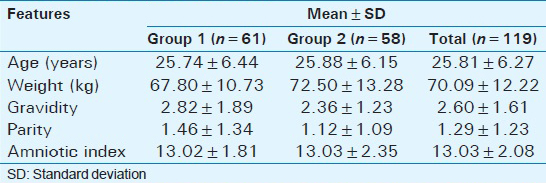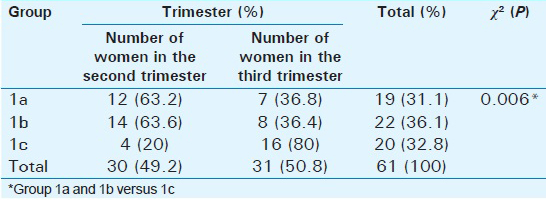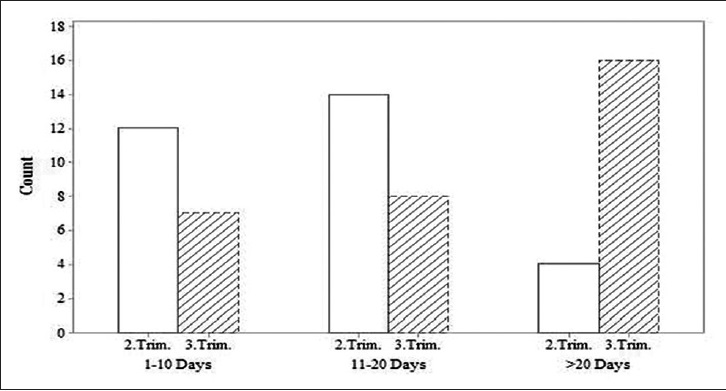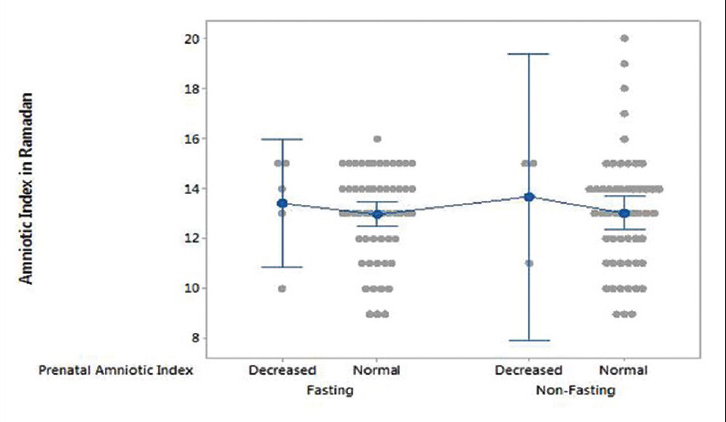Translate this page into:
The Influence of Fasting in Summer on Amniotic Fluid During Pregnancy
Address for correspondence: Dr. Ayşegül Altunkeser, Department of Radiology, Konya Education and Research Hospital, Meram, Konya, Turkey. E-mail: aaltunkeser@hotmail.com
-
Received: ,
Accepted: ,
This is an open access article distributed under the terms of the Creative Commons Attribution-NonCommercial-ShareAlike 3.0 License, which allows others to remix, tweak, and build upon the work non-commercially, as long as the author is credited and the new creations are licensed under the identical terms.
This article was originally published by Medknow Publications & Media Pvt Ltd and was migrated to Scientific Scholar after the change of Publisher.
Abstract
Objectives:
Ramadan is a holy month in which eating and drinking are forbidden from dawn to sunset. In this study, we investigated using ultrasonography (USG) whether fasting in summer (as occurred in Ramadan 2014) had an influence on the volume of amniotic fluid during pregnancy.
Materials and Methods:
The study included 119 pregnant women in total who were admitted to our department with a request of obstetric USG between June 28, 2014, and July 27, 2014. The fasting group included 61 pregnant women and the control group of 58 pregnant women. In our study, all the fasting pregnant women had Sahur (predawn meal eaten before starting fasting) and Iftar (the evening meal for fast-breaking) every day, regularly. The women in the control group did not fast. In addition to amniotic fluid index and fetal biometric measurements during Ramadan, amniotic fluid volume was measured ultrasonographically throughout pregnancy. All ultrasound examinations were performed at least 8 h after Sahur during Ramadan. Chi-square test was utilized to compare the measurements of amniotic fluid volume, and Mann–Whitney U-test was utilized to analyze the differences in fetal growth data. Moreover, difference was considered statistically significant when the P value was <0.05.
Results:
The mean age was 25.7 years in the fasting group and 25.8 years in the control group. Other characteristics and mean gestational weeks of the two groups were similar. Ultrasonographically, there was no significant difference between two groups in respect to amniotic fluid amount during pregnancy (P = 0.7). There was no significant difference with regard to fetal growth parameters either (P > 0.05).
Conclusion:
In pregnant women who had regular predawn and fast-breaking meals, fasting in summer did not elicit alteration in the amount of amniotic fluid throughout pregnancy.
Keywords
Amniotic fluid
Ramadan
ultrasonography

INTRODUCTION
Ramadan is a holy month of the Islamic calendar and is observed by Muslims as a month of fasting. During 1 month, eating and drinking are forbidden during the period between sunrise and sunset. Since the Islamic calendar is a lunar calendar which is 11 days shorter than a solar year, this month is observed 11 days earlier every year. Therefore, daily fasting period and air temperature vary with every Ramadan. Some of the pregnant women want to fast that month but are concerned about their and baby's health. Moreover, these concerns of pregnant women who want to fast augment when Ramadan coincides with summer since fasting periods become longer and air temperature gets higher.
Amniotic index (AI) is one of the five parameters for the assessment of the biophysical profile of the fetus in the prenatal period.[1] The others are fetal breathing movement, fetal tone, fetal body movement, and fetal heart rate. Therefore, the measurement and follow-up of the amniotic fluid amount are important for the evaluation of fetal status. The measurement of AI with ultrasonography (USG) is easily performed with a single deepest vertical pocket or four-quadrant method and gives important information about fetal status.[2345] Previous studies showed results about changes in amniotic fluid during the fasting month; however, we did not encounter a study in the literature that dealt with the change in the amount of amniotic fluid during the fasting period and between the end of fasting month and delivery. Furthermore, some of these studies were performed in Ramadan months which coincided with shorter and cooler days.[67] The Ramadan of 2014 when our study was performed coincided with long, hot summer days. In this study, we investigated whether fasting in long, hot days had an influence on the amount of amniotic fluid after the end of fasting month up to delivery, using USG. Moreover, we also studied the effect of fasting on fetal growth.
MATERIALS AND METHODS
The study, which is a case-control, included 119 fasting or not fasting pregnant women in total, who were referred in their second or third trimester to the Radiology Department of Dr. Faruk Sukan Maternity and Children's Hospital for obstetric USG between June 28, 2014, and July 27, 2014. This study was approved by the local ethical committee in Necmettin Erbakan University, and informed consent was obtained from every pregnant woman enrolled in the study. All the women included in the study had singleton pregnancy, were healthy, experienced no complications during pregnancy, and were shown to have sufficient amount of amniotic fluid, at least 9 cm, in USG examination during Ramadan. Sixty-one fasting women constituted Group 1 and 58 nonfasting women formed Group 2 which was the control group. Women with anomalous fetuses, oligohydramnios, polyhydramnios, and twin pregnancies were excluded from the study. Fasting pregnant women were individuals who were eating Iftar and Sahur meals regularly and paying attention to their fluid intake, as well. All ultrasound examinations were performed at least 8 h after Sahur by a radiologist aware of their fasting or not fasting during Ramadan. During USG examination, Group 1 was further subdivided according to the number of fasting days as Group 1a (1–10 days), Group 1b (11–20 days), and Group 1c (21–30 days). Data including age, weight, gravidity, parity, trimester, and AI obtained from four-quadrant method were recorded from all subjects. Amniotic fluid amount was measured with ultrasonographic follow-up until delivery, and an AI <5 cm in the third trimester and perinatal period was considered low while those with more than 5 cm were considered sufficient.[8] USG examination was performed by an experienced radiologist with Siemens (Acuson Antares; Erlangen, Germany) and Toshiba (Famio 8; Tokyo, Japan) branded instruments. Data about delivery including week and mode of delivery and data about newborn including weight, height, and Apgar score were noted, as well. The results of the measurement of amniotic fluid amount with ultrasonographic follow-up were compared between Groups 1 and 2. Furthermore, whether fasting had impact on fetal growth and perinatal course was investigated.
Statistical analysis
Descriptive statistics in Groups 1 and 2 were presented as mean ± standard deviation. The normalities of continuous variables were controlled with Kolmogorov–Smirnov test. The comparison between the USG findings of Groups 1 and 2 was performed with Pearson, and Fisher exact, Chi-square tests, whereas the differences about fetal growth parameters were analyzed with Mann–Whitney U-test. Statistical analyses were performed using IBM SPSS for Windows 13.0, and P < 0.05 was considered statistically significant.
RESULTS
All the subjects underwent USG follow-up in Ramadan 2014 until delivery. Data about delivery and the newborn were missing in two subjects because delivery did not take place in our hospital. Descriptive statistics about age, weight, gravidity, parity, trimester, and AI were similar between the groups [Table 1a]. In Group 1 comprising 61 pregnant women, the mean age was 25.7 years; 30 were in the second and 31 in the third trimester. In the control group forming Group 2, the mean age was 25.8 years; 28 pregnant women were in the second and 30 were in the third trimester [Table 1b]. As for the subdivisions of Group 1, 36% of the pregnant women constituting Group 1a (1–10 days) and Group 1b (11–20 days) and 80% of those in Group 1c (21–30 days) were in the third trimester [Table 1c and Figure 1].




- Trimester information about the subdivisions of Group 1.
The mean AI during Ramadan was 13.02 ± 1.81 cm (minimum 9 cm, maximum 16 cm) in Group 1 and 13.03 ± 2.35 cm (minimum 9 cm, maximum 20 cm) in Group 2 [Table 1a]. The amount of amniotic fluid was sufficient in 56 subjects within Group 1 but low in 5. Within the control group, it was sufficient in 55 but low in 3 pregnant women. AI was accepted as enough if it was ≥ 5 cm in the perinatal period. There was no statistically significant difference between two groups with regard to follow-up amniotic fluid amount (P = 0.718) [Table 2a and Figure 2]. However, there was a significant relation between follow-up amniotic fluid amount and trimesters. Of 8 in total within two groups, 7 pregnant women with low amniotic fluid were in the second trimester [Table 2b]. Of these, 4 were in Group 1 and 3 were in Group 2.


- Comparison of amniotic fluid amounts between the groups.

The mean delivery week was 39.2 in Group 1 and 38.8 in Group 2 (P = 0.18). In Group 1 newborns, the mean weight was 3305 ± 434 g, the mean height was 50.2 ± 1.42 cm, and the mean Apgar score was 9.6 ± 0.65; in Group 2, these averages were 3268 ± 654 g, 49.9 ± 2.03 cm, and 9.5 ± 0.56, respectively (P = 0.36, P = 0.29, P = 0.13; respectively). As for the mode of delivery, 46 pregnant women had normal delivery in Group 1 and 31 had normal delivery in the control group; the difference was statistically significant (P = 0.022) [Table 3].

DISCUSSION
This study aimed to investigate the effect of fasting in summer when the fasting period is longer, on the amount of amniotic fluid from the end of fasting until delivery, with the use of USG. The assessment of the amniotic fluid with USG is an important parameter to determine fetal well-being.[9] AI gives information about fetal renal perfusion sufficiency; indeed, its lowness is associated with higher perinatal morbidity and mortality.[1011] Therefore, we believe that the inclusion of pregnant women who fasted during June and July when fasting period was as much as 17 h a day and mean temperature was 31°C in the shade[12] made our study on the assessment of amniotic fluid with USG more meaningful.
Previous studies on the effect of fasting on AI were investigated using USG and Doppler USG parameters. These studies especially examined umbilical and uterine artery Doppler indices that gave insight into amniotic fluid and fetomaternal circulation. Some of these studies coincided with autumn months when hunger and thirst period was shorter and air temperature was cooler and reported that fasting did not change USG and Doppler USG parameters.[71314] However, summertime studies in which fasting period was longer and air temperature was higher found different results with regard to the amount of amniotic fluid. Moradi reported that fasting did not influence amniotic fluid amount, whereas Sakar et al., showed that AI was increased in nonfasting pregnant women and Seckin et al., displayed that it decreased in fasting people.[151617] In line with these studies, we noticed that fasting – regardless of season – did not change Doppler indices including resistive index, pulsatility index, and systolic/diastolic ratio of umbilical artery, middle cerebral artery, and uterine artery associated with fetomaternal circulation. However, its effect on AI was different, especially in summertime studies. In a study by Seckin et al., it was suggested that longer fasting periods and higher air temperature could result in low AI. However, Moradi reported that AI did not change although fasting period coincided with hot days with longer fasting periods.[15] From these studies, we could obtain information about the effect of fasting during Ramadan on AI. Nonetheless, we could not find information in the literature about subsequent effects of fasting on amniotic fluid amount after the end of Ramadan until delivery. Therefore, we investigated possible late effects of fasting on amniotic fluid and found that it did not alter the amount of amniotic fluid in periods following fasting, using ultrasonographic follow-up. Our study coincided with summer and amniotic fluid amount did not alter. The pregnant women with decreased amniotic fluid were especially those with the first ultrasonographic examination in the second trimester [Table 2b]. We should underline that both groups were healthy individuals who had regular Sahur and Iftar meals and who paid attention to fluid intake. We believe that fasting has no subsequent effect on amniotic fluid amount as long as regular and sufficient daily food and fluid intake is ensured. Dikensoy et al., reported that fasting did not influence fetal growth.[13] Cross et al., also reported that fasting did not change the mean birth weight and that the babies whose mother fasted during the second trimester had normal birth weight.[18] In another study, it was found that fasting did not affect fetal growth in healthy pregnant women who paid attention to their nutrition.[19] Our study showed that fasting even on long and hot summer days had no influence on fetal growth in accordance with the studies mentioned above.
Limitations
Our study has several limitations. First, case number was not enough to obtain relevant statistical results. Second, there were no pregnant women who did not have Sahur and Iftar meals.
CONCLUSION
Fasting had no effect on the amount of amniotic fluid throughout pregnancy in pregnant women who were attentive to have regular Sahur and Iftar meals and sufficient fluid intake.
Financial support and sponsorship
This study was not funded by any organization.
Conflicts of interest
There are no conflicts of interest.
Available FREE in open access from: http://www.clinicalimagingscience.org/text.asp?2016/6/1/21/183041
REFERENCES
- Antepartum fetal evaluation: Development of a fetal biophysical profile. Am J Obstet Gynecol. 1980;136:787-95.
- [Google Scholar]
- Amniotic fluid index versus single deepest vertical pocket as a screening test for preventing adverse pregnancy outcome. Cochrane Database Syst Rev. 2008;3:CD006593.
- [Google Scholar]
- Reproducibility of measuring amniotic fluid index and single deepest vertical pool throughout gestation. Prenat Diagn. 2015;35:434-9.
- [Google Scholar]
- Reference ranges of amniotic fluid index in late third trimester of pregnancy: What should the optimal interval between two ultrasound examinations be? J Pregnancy 2015 2015:319204.
- [Google Scholar]
- Effect of fasting during Ramadan on fetal development and maternal health. J Obstet Gynaecol Res. 2008;34:494-8.
- [Google Scholar]
- Four-quadrant assessment of gestational age-specific values of amniotic fluid volume in uncomplicated pregnancies. Acta Obstet Gynecol Scand. 1998;77:290-4.
- [Google Scholar]
- Low amniotic fluid index as a predictor of adverse perinatal outcome. J Perinatol. 2002;22:282-5.
- [Google Scholar]
- Accuweather, Inc. Weather in July, 2014. Available from: http://www.accuweather.com/tr/tr/konya/318795/july-weather/318795
- [Google Scholar]
- The effect of Ramadan fasting on maternal serum lipids, cortisol levels and fetal development. Arch Gynecol Obstet. 2009;279:119-23.
- [Google Scholar]
- Effect of maternal fasting on uterine arterial blood flow. J Obstet Gynaecol Res. 2007;33:151-4.
- [Google Scholar]
- The effect of Ramadan fasting on fetal growth and Doppler indices of pregnancy. J Res Med Sci. 2011;16:165-9.
- [Google Scholar]
- Ramadan fasting and pregnancy: Implications for fetal development in summer season. J Perinat Med. 2015;43:319-23.
- [Google Scholar]
- Effect of maternal fasting for religious beliefs on fetal sonographic findings and neonatal outcomes. Int J Gynaecol Obstet. 2014;126:123-5.
- [Google Scholar]
- Ramadan and birth weight at full term in Asian Moslem pregnant women in Birmingham. Arch Dis Child. 1990;65:1053-6.
- [Google Scholar]
- The effect of Ramadan fasting on outcome of pregnancy. Iran J Pediatr. 2010;20:181-6.
- [Google Scholar]






